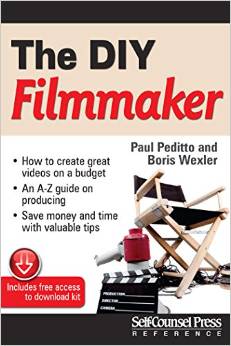Let’s start with a no-no: Backstory in screen direction:
EXT. PARADE ROUTE- BRIGHT DAY
Jillian watches as the pageant parade passes, seeming to remember the day she was crowned Miss Southeast Panhandle State 1956. There was a goldenrod sun that day too, and as she drove along waving from the festooned Wheaties Breakfast of Champions float, all manner of soon-to-be Mickey Mantles followed, hoping she would throw them a souvenir Wheaties box. It was a glorious, glorious day!
All the sadder that Jillian now peels an orange, watching the new beauty queen pass, thinking how unfair life is, wondering if there is indeed a God at all.
Good Reader, don’t do this! The camera can’t see Jillian’s beauty queen past. It can’t see her ponderings on Life and Eternity.
How would you change this screen direction?
Ask yourself: What is the purpose of the scene? What do you need to happen? What are you trying to say? The whole passage, really, could be boiled down to…
INT. PARADE ROUTE- DAY
Jillian watches the beauty queen pass, her nails grinding the orange she holds into pulp.
The essence of the scene is Jillian’s attempt to cope with mortality, and her failure, as the parade rolls by.
Find the action, the physical equivalent, some business the actor can play, rather than hitting us with backstory (everything that happened before the movie began) that the camera can’t see.
Also avoid unnecessary detail, like this:
INT. CASINO- NIGHT
Pauly Vegas walks in, placing left foot in front of right, making his way to a craps table. He checks the table limit, a 25 dollar game, shakes his head and sighs, on the move again.
Pauly reaches into his pocket, finds some lint, a winter-fresh breath mint, the pink dry cleaning ticket from his Colombian laundry joint that never has his clothes ready on time, and a single dollar chip. Motioning with his left hand to the waitress for a gin and tonic refill, he smirks as he sees a blue-haired Bayonne lady squeal and scoop up her video poker winnings. Pauly bobs his head, all smiles as he finally spies, yes! A table!
This is not just unnecessary detail, but the wrong detail. The purpose of the scene is…what? Do you really believe the actor will care that on page 66, midway down the page, the writer wants him to shake his head and sigh before motioning with his left hand for a gin and tonic? Never going to happen. Waste of space, and a drag on the reader’s eye. Don’t do it.
Don’t do the production designer’s job either. If you want to tell me about the cat passing the fauve 19th Century Ming vase, that vase better be needed to tell the story. The damn cat too. A general rule: If in doubt, take it out. Cut everything you can. Does the scene still make sense? If you cut Pauly shaking his head and smiling, does the scene fall apart? No. Then it stays out.
Develop a cut instinct. Readers have only so much “eye.” If you kill them with screen direction, you feed the tendency to skip screen description altogether and read only the dialogue. Keep your screen direction lean and mean.
Pro screenwriters find a way to get their voices into screen direction. How do they do that?
They cheat. Like this:
INT. ROGER’S ROOM- DAY
Roger drags himself out of bed. He looks for his shirt, finds it and throws it on, finds his socks too, but...where are his pants?
ROGER
Honey, have you seen--
WIFE (O.S.)
What?
As Roger looks under the bed, something catches his eye. He pulls out, brilliant and fluorescent green, a man’s cuff link. What the...? Never, in his life, has he owned a cuff link, let alone freakin’ fluorescent green.
The part about never owning a cuff link can’t be seen. What can be seen is Roger’s face, his confusion. This comes from finding another man’s cuff link. This can be seen, thus is ok for screen direction. The worry that Roger’s wife might be cheating comes across without a word of dialogue. Rather than tell us: Roger is upset because seven years ago his wife had an affair that he still has nightmares over. He goes to a shrink to this day over it. The shrink’s name is Stanley Gladhands and he lives on…
Get it? Finesse screen direction, cheat it, but save the cheating for a key moment or scene. Don’t overuse the device, don’t get cute.
Here’s an example from Backdraft:
INT. ELEVATED TRAIN – MORNING
A pissed-off Chicago, hauling itself off to work in the morning snap, passes by Brian’s window. Tough Midwestern brick. Tough Midwesterners. Heads-down in their 150 year war with a wind committed to pushing the whole damn thing into Lake Michigan.
What a marvel this little paragraph is! Anyone living in Chicago–especially those of us who take the EL every day—can attest to the truth in that passage. If you were just following the KISS (keep it simple, stupid) approach, you would write something like: Brian rides a grimy subway car. There is nothing wrong with this. Describes what the camera sees. Problem is, anyone can write Brian rides a grimy subway car. Now look at the above example. Look how the writer puts you into the head of the protagonist. This is POV. It is advanced screenwriting. It’s what separates the pro from everyone else. Do you think the fact that you can’t see “their 150 year war with wind” is going to be penalized by the reader at that prodco/screenplay contest/agency? Hell no. Those eyes are starved for originality. The pro gives it to them with POV, with attitude. Thus, the true definition of screen direction: What the camera sees—with attitude.


Hey, this helped a bit thank you haha, im a idealist and want to be a director when im older, have alot of story ideas and at the moment working on my master piece film for my cinema class if you got any more tips please feel free to email me, thank you.